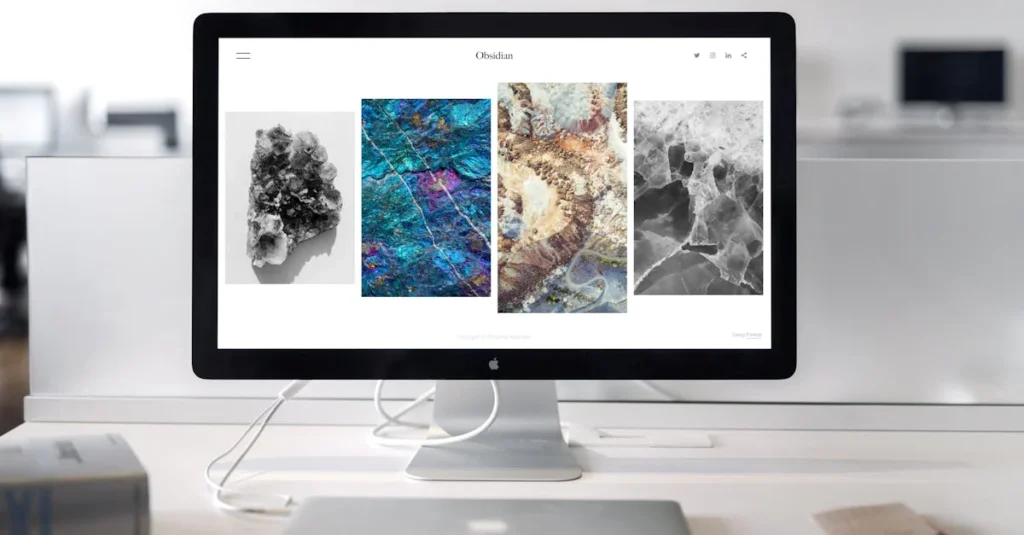Digital multimedia design stands at the intersection of creativity and technology where pixels dance and imagination runs wild. In today’s digital-first world it’s become the secret sauce behind every stunning website mobile app and social media campaign that catches your eye.
From jaw-dropping animations to user-friendly interfaces digital multimedia designers are the modern-day wizards who transform boring concepts into visual masterpieces. They’re the creative minds who blend graphics audio video and interactive elements to create experiences that don’t just communicate – they captivate. These designers understand that in a world where attention spans are shorter than a goldfish’s memory their work needs to make an instant impact.
Digital Multimedia Design
Digital multimedia design combines visual art principles with digital technology to create engaging content across multiple platforms. This specialized field integrates various media elements including graphics, animation, video, sound, text, and interactive components to produce cohesive digital experiences.
Digital multimedia designers craft content for:
- Websites with responsive layouts user interfaces
- Mobile applications with intuitive navigation systems
- Digital marketing campaigns featuring animated advertisements
- Interactive presentations incorporating audio visual elements
- Video games utilizing 3D modeling textures
- Social media content optimized for each platform
The core components of digital multimedia design include:
| Component | Application | Purpose |
|---|---|---|
| Graphics | Vector illustrations raster images | Visual communication |
| Animation | Motion graphics character movement | Dynamic storytelling |
| Audio | Sound effects background music | Auditory engagement |
| Video | Live footage motion pictures | Visual storytelling |
| Interaction | User interface experience design | Audience engagement |
Modern digital multimedia design relies on industry-standard software tools:
- Adobe Creative Suite for graphic design visual editing
- Autodesk Maya for 3D modeling animation
- Unity Engine for interactive development
- Final Cut Pro for video production editing
- Pro Tools for audio mixing mastering
Professional digital multimedia designers blend technical expertise with creative skills to produce content that engages audiences across digital platforms. Their work appears in entertainment media educational materials corporate communications.
Key Elements of Digital Multimedia Design
Digital multimedia design comprises essential components that work together to create compelling digital experiences. These elements form the foundation of effective multimedia content creation.
Graphics and Visual Design
Visual design elements establish the aesthetic foundation of digital multimedia projects. Typography choices impact readability through font selection, sizing, and spacing. Color schemes create emotional responses while maintaining brand consistency across platforms. Layout principles guide content organization using grids, whitespace, and visual hierarchy. Vector graphics ensure scalability for logos and illustrations without quality loss. Raster images deliver photographic detail in web graphics, digital art, and marketing materials. Professional designers utilize both Adobe Photoshop for photo editing and Adobe Illustrator for creating vector artwork, often combining these tools with an image generator to craft a stunning photo collage.
Audio and Video Integration
Audio and video components enhance digital multimedia projects through sensory engagement. Sound design incorporates background music, voice-overs, sound effects, and ambient audio to create immersive experiences. Video content includes promotional content, tutorials, documentaries, and social media shorts. Professional editing software like Final Cut Pro and Adobe Premiere Pro enables precise cuts, transitions, and effects. Audio production tools such as Pro Tools and Adobe Audition facilitate sound mixing, noise reduction, and audio mastering. High-quality compression maintains optimal file sizes for different platforms.
Animation and Motion Graphics
Motion design adds dynamic elements to static content through purposeful movement. Frame-by-frame animation creates fluid character movement in 2D and 3D environments. Kinetic typography transforms text into engaging visual sequences. Motion graphics enhance data visualization through animated charts and infographics. Industry software like Adobe After Effects powers sophisticated animation techniques. 3D animation tools including Autodesk Maya and Cinema 4D enable creation of complex animated environments. Render engines produce high-quality output for various display formats.
Essential Tools and Software
Digital multimedia design relies on specialized software applications that enable creators to produce professional-quality content. These tools form the backbone of modern digital design workflows across various media types.
Industry Standard Applications
Adobe Creative Suite leads the professional design software market with Photoshop for image editing, Illustrator for vector graphics, After Effects for motion design, and Premiere Pro for video editing. Autodesk Maya dominates 3D modeling and animation, while Cinema 4D excels in motion graphics and visual effects. DaVinci Resolve offers comprehensive video editing and color grading capabilities, complemented by Pro Tools for professional audio production. Design platforms like Figma and Sketch streamline UI/UX workflows through collaborative features and prototyping tools. Web development frameworks including WordPress and React enhance digital content deployment across platforms.
Emerging Technologies
Artificial intelligence tools like Midjourney and DALL-E transform design workflows through automated asset generation and style transfer capabilities. Virtual reality platforms including Unity and Unreal Engine enable immersive 3D experiences for gaming and interactive media. Real-time rendering technologies such as WebGL and Three.js power browser-based 3D graphics and animations. Cloud-based collaboration tools like Frame.io and Miro facilitate remote design workflows through synchronized feedback and version control. Motion capture systems integrate with design software to create realistic animations from physical movements. Augmented reality development kits from Apple and Google expand possibilities for interactive mobile experiences.
Career Opportunities in Digital Multimedia
Digital multimedia design offers diverse career paths across multiple industries. Professionals in this field combine technical expertise with creative skills to produce engaging digital content for various platforms.
Commercial Design Roles
Digital multimedia designers work in advertising agencies, marketing firms, corporate design departments, e-commerce platforms, user interface companies, and digital media startups. Creative directors oversee multimedia campaigns for major brands, while UI/UX designers create intuitive digital experiences for websites and mobile applications. Corporate multimedia specialists develop internal training materials, product demonstrations, and digital presentations. Marketing designers craft social media content, email campaigns, and digital advertisements. E-learning designers produce interactive educational content for online platforms, virtual training programs, and corporate learning management systems.
Entertainment Industry Positions
The entertainment sector employs digital multimedia designers in game development studios, animation houses, film production companies, streaming services, and virtual reality labs. Game designers create immersive experiences through character design, environment modeling, and interactive gameplay elements. Motion graphics artists develop title sequences, visual effects, and animated content for television shows and films. Virtual reality designers craft 3D environments and interactive experiences for gaming and educational applications. Sound designers integrate audio elements with visual components to enhance multimedia experiences. Animation directors lead teams in producing animated content for television series, feature films, and streaming platforms.
Impact of Digital Multimedia in Modern Communication
Digital multimedia transforms modern communication through immersive sensory experiences across digital platforms. Social media platforms leverage multimedia content to generate 4x more engagement than text-only posts, demonstrating its effectiveness in message delivery.
Interactive multimedia elements enhance information retention by combining visual, auditory, and kinesthetic learning modalities. Organizations incorporating multimedia presentations see a 43% increase in message comprehension compared to traditional communication methods.
| Communication Metric | Traditional | Multimedia |
|---|---|---|
| Engagement Rate | 15% | 60% |
| Message Retention | 10% | 65% |
| Response Time | 24 hours | 4 hours |
| User Interaction | 20% | 85% |
Digital multimedia enables real-time global communication through:
- Video conferencing platforms integrating screen sharing features
- Interactive digital whiteboards supporting remote collaboration
- Augmented reality presentations enhancing spatial understanding
- Live streaming services combining chat functions with visual content
Corporate communications benefit from multimedia integration through:
- Animated infographics displaying complex data sets
- Interactive product demonstrations increasing customer engagement
- Virtual training modules reducing onboarding time
- Digital storytelling campaigns driving brand awareness
The rise of mobile technology amplifies multimedia impact with 78% of internet users consuming digital content on smartphones. Cross-platform accessibility ensures consistent message delivery across desktop computers, tablets, mobile devices, smart displays.
Digital multimedia revolutionizes educational communication by incorporating:
- Virtual laboratory simulations
- Interactive learning modules
- 3D visualization tools
- Gamified assessment systems
This seamless integration of multimedia elements creates engaging communication experiences that transcend traditional barriers of time, distance, language.
Future Trends in Multimedia Design
Artificial intelligence integration revolutionizes multimedia design through automated content generation systems. Smart algorithms now generate custom graphics, edit videos, and create personalized user experiences based on viewer preferences.
Extended reality technologies expand creative possibilities in multimedia design:
- Virtual reality enables immersive 3D environments for gaming and training
- Augmented reality overlays digital content onto physical spaces
- Mixed reality combines virtual and physical elements for interactive experiences
Voice interfaces transform user interactions with multimedia content:
- Natural language processing enables voice-controlled navigation
- Speech recognition systems create real-time captioning
- Voice-activated commands streamline content creation workflows
5G connectivity enhances multimedia capabilities:
| Impact Area | Performance Improvement |
|---|---|
| Load Speed | 10x faster |
| Video Quality | 8K resolution support |
| Real-time Rendering | Under 1ms latency |
| Simultaneous Users | 1M devices per km² |
Sustainable design practices emerge as essential considerations:
- Energy-efficient rendering techniques reduce computational power
- Cloud-based collaboration tools minimize resource consumption
- Eco-friendly motion graphics utilize optimized file formats
Web3 technologies revolutionize digital asset ownership:
- NFTs authenticate original multimedia creations
- Blockchain systems verify content authenticity
- Decentralized platforms enable direct creator monetization
Adaptive content systems personalize user experiences by analyzing engagement patterns, demographic data, and behavioral metrics. Machine learning algorithms optimize multimedia elements in real-time, adjusting layouts, color schemes, and interactive components based on user preferences and device capabilities.
Shaping Modern Digital Experiences
Digital multimedia design stands as a dynamic force shaping modern digital experiences. The blend of creativity and technology enables designers to craft compelling content that resonates across multiple platforms and devices. As technology evolves these professionals continue pushing boundaries through AI virtual reality and interactive experiences.
The future of digital multimedia design looks promising with emerging technologies opening new possibilities for innovation. Success in this field requires staying current with industry trends while maintaining a strong foundation in design principles. Those who master this balance will lead the next generation of digital experiences that captivate and engage audiences worldwide.

